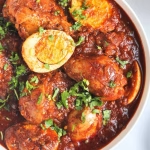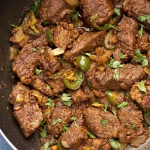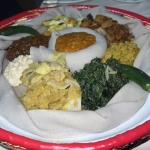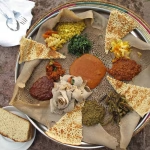Introduction
Ever heard of **Kitcha (Traditional Bread)**? If you haven’t, you’re in for a treat! Kitcha is a delicious flatbread that originates from Ethiopia, known for its unique flavors and versatility. This bread is often enjoyed with a variety of dishes, making it a staple in Ethiopian households. What sets Kitcha apart is its slightly crispy exterior and soft, chewy interior, which brings a comforting feel to your meals.
In this article, we’ll guide you through the process of making Kitcha (Traditional Bread) at home, exploring essential **Kitcha (Traditional Bread) ingredients**, variations, and tips that will elevate your bread-making skills. Get ready to impress your family and friends with the best **Kitcha (Traditional Bread) recipe** they’ve ever had!
Ingredients
Here’s your shopping list for creating scrumptious Kitcha (Traditional Bread). Each ingredient plays a vital role in delivering that traditional flavor.
| Ingredient | Measurement | Description |
|---|---|---|
| All-purpose flour | 2 cups | All-purpose flour is the base of Kitcha, providing the necessary structure and texture. |
| Warm water | 3/4 cup | Warm water activates the gluten, ensuring your Kitcha is soft and pliable. |
| Salt | 1 teaspoon | Salt enhances the flavor and balances the sweetness of the bread. |
| Vegetable oil | 1 tablespoon + extra for frying | Vegetable oil helps achieve that perfect golden crust while frying. |
| Fresh garlic (optional) | 2 cloves, minced | Fresh garlic enhances the aroma and depth of flavor in Kitcha (Traditional Bread). |
Step-by-Step Instructions
Making Kitcha (Traditional Bread) at home is simple and satisfying! Just follow these steps:
- Prepare the Dough – In a large bowl, combine the all-purpose flour and salt. Slowly add warm water while mixing with your hands or a wooden spoon until a shaggy dough forms.
- Knead the Dough – Transfer the dough to a lightly floured surface. Knead for about 5-7 minutes until it becomes smooth and elastic. If you’re using fresh garlic, add it during the kneading process for that aromatic punch.
- Rest the Dough – Place the kneaded dough back into the bowl, cover with a damp cloth, and let it rest for 30 minutes. This resting period is key for achieving the right texture.
- Shape the Kitcha – Once rested, divide the dough into four equal portions. Roll each portion into a flat circle, about 1/4 inch thick.
- Fry the Kitcha – Heat a non-stick pan over medium heat. Add a little vegetable oil, then place your rolled dough in the pan. Cook for about 2-3 minutes on each side until golden brown.
- Serve and Enjoy – Remove the Kitcha from the pan and place it on a plate. Serve warm with your favorite sauces, like spicy *berbere* sauce or tangy yogurt for a perfect pairing!
Pro Tips
Here are a few expert tips to ensure your Kitcha turns out perfectly every time:
- Use Fresh Ingredients: Fresh flour and spices make a significant difference in flavor. Avoid stale ingredients to enhance your overall dish.
- Adjust Thickness: Depending on your preference, you can make your Kitcha thicker or thinner. Just remember, thicker Kitcha may require a bit more cooking time.
- Keep it Warm: Cover cooked Kitcha with a kitchen towel to keep it warm and soft until serving.
- Experiment with Flavors: For variations, feel free to add herbs like rosemary or spices like cumin to the dough.
- Pair with Dips: Kitcha goes wonderfully with dips; try it with *shiro* or *hummus* for a delightful experience.
Nutritional Information
Curious about what you’re putting on your plate? Here’s a brief nutritional breakdown for one serving of Kitcha (Traditional Bread):
| Nutrient | Amount per Serving |
|---|---|
| Calories | 170 |
| Protein | 4g |
| Carbohydrates | 30g |
| Saturated Fats | 1g |
| Fiber | 1g |
| Cholesterol | 0mg |
| Sugars | 0g |
| Fat | 4.5g |
FAQs
Here are some frequently asked questions about Kitcha (Traditional Bread) that might help you along your culinary journey:
What is the best way to store Kitcha (Traditional Bread)?
Kitcha is best stored at room temperature in an airtight container. If you live in a humid area, refrigerate it to prevent spoilage.
Can Kitcha (Traditional Bread) be made vegan or gluten-free?
Absolutely! You can use gluten-free flour for a gluten-free version, and vegetable oil makes it vegan-friendly!
What are the best side dishes to serve with Kitcha (Traditional Bread)?
Kitcha pairs well with spicy *berbere*, lentil stew, or even a fresh salad for a balanced meal.
How long does it take to prepare Kitcha (Traditional Bread)?
From start to finish, it takes about an hour to prepare and cook Kitcha.
Can I freeze Kitcha (Traditional Bread) for later?
Yes! You can freeze Kitcha after cooking. Just place parchment paper between each piece to prevent sticking and thaw as needed.
Is Kitcha (Traditional Bread) healthy?
Kitcha can be part of a healthy diet when enjoyed in moderation. It provides carbs for energy and can be paired with protein and vegetables.
What variations of Kitcha can I try?
You can try spicing it up with herbs like thyme or adding seeds for a different texture.
What type of flour is best for Kitcha?
While all-purpose flour is the most common, experimenting with whole wheat flour can add extra nutrients and a unique flavor.




